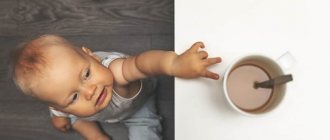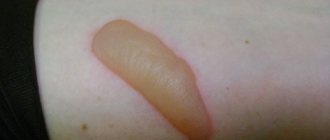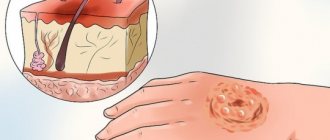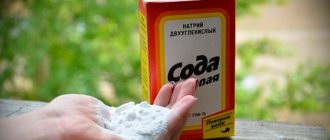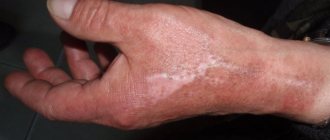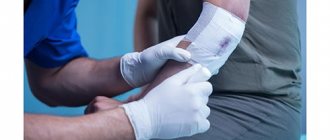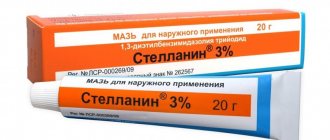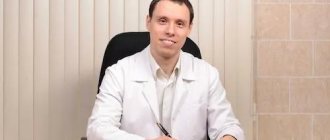Number of views: 63,987
Children are always on the move, actively exploring the world. No matter how carefully adults watch the baby, from time to time he manages to fall, get a bump, or pour hot liquid on himself. A burn in a child is a very painful experience. Such injuries account for approximately 30% of all childhood injuries. In this case, it is important for adults to know what to do in such situations.
Depending on the method of receipt and the degree of damage, burns are divided into groups.
Thermal burn
Thermal burn in a child is the most common type. Occurs if the baby spills boiling water or comes into contact with an open fire or hot objects. Unfortunately, not only a little fidget left unattended can get burned. A toddler sitting on his mother's lap is capable of suddenly waving his arm or leg and knocking a cup of hot tea out of her hands.
Precautionary measures:
- Don't pick up your baby while holding something hot.
- Check the temperature of the food you feed your baby
- Unfold the handles of pots and pans so that the child cannot reach them.
- Temporarily remove the tablecloth from the table - the baby may pull on it and throw hot food onto himself
- Control the temperature of the bathing water, it should not be higher than 38⁰С
- Cover the child's seat in the car with a towel; in summer, the surface of the seat can become excessively hot and burn the child's delicate skin.
- Cover the radiators with screens, during the heating season the radiators can be scalding
- Use a special protective screen for the stove and oven
Any mother knows how to do more than just cook dinner or iron when the child is awake. Sometimes you have to show miracles of ingenuity and multitask. But following safety rules will avoid many dangers. It is better to think about how to protect your child than to discover a burn on a child.
Chemical burn
A chemical burn in a child occurs through direct contact with chemically aggressive substances , which include acids, alkalis, and professional household chemicals. In everyday life, such cases, unfortunately, are not rare. Children actively explore the surrounding space and try everything they can reach.
If a child suffers a skin burn, it is important to remove excess substance with a dry cloth and then rinse the affected area with warm water for 20 minutes.
If you discover that your baby has stained his clothes with chemical powder, do not remove things over his head, as this can damage his face and eyes. Cut and remove such clothing.
The most difficult case is that a child swallowed a chemical substance. It is important to understand what he drank and, if possible, keep the liquid in the original packaging (if necessary, show it to doctors). You should not urgently remember your school chemistry course and try to neutralize the substance yourself - the likelihood of an error is extremely high.
You must not induce vomiting! When vomited, a dangerous substance can enter the respiratory tract or cause swelling of the larynx. Gastric lavage is also contraindicated; it can cause secondary damage to the esophagus and oral cavity. The oral mucosa should be rinsed generously with water, but in such a way that the child does not swallow anything. You should immediately consult a doctor. Precautionary measures:
- Eliminate the possibility of your baby coming into contact with hazardous substances
- As soon as the child begins to crawl, remove all medications and household chemicals
- Store all substances in their original packaging so that you can familiarize yourself with the composition
- It is better to remove hazardous substances from the home
How to prevent
Most cases of childhood burns are the responsibility of parents and other adults who leave children unattended in potentially dangerous places. Therefore, when a child appears in the house, all family members must follow the following rules.
- Do not drink or eat hot food while the baby is in your arms.
- Cook food only on the far burners.
- Keep potentially dangerous objects as far away from the edge of the table as possible.
- When preparing a bath, turn on cold water first, and then hot, thoroughly mixing the layers. Remember that water at a temperature of +50 ℃ can be dangerous for a child!
- For sunbathing, use only early morning hours and use sunscreen.
- If possible, do not use extension cords; try to secure electrical wires and cords so that the child does not grab them if he falls.
- Keep electrical appliances as far as possible from children and water sources.
- Hide candles and matches.
- Keep household cleaning products and other chemicals out of the reach of children.
Electrical burn
Children get electrical burns when they come into contact with faulty household electrical appliances, when trying to insert foreign objects into an outlet, and so on.
If a child is injured by an electric shock, the first step is to break the contact of the victim with the electrical source. Trying to simply pick up the baby in your arms can lead to the mother being exposed to the current. In this case, it is necessary to push the child aside.
When examining your baby, remember that electric current has an entry point and an exit point. If you notice a burnt point on the handle (presumably the entry point), then be sure to find the exit point as well. The damaged areas should be covered with a sterile bandage.
A feature of an electrical burn is the relative integrity of the outer skin and serious injury to internal tissues (nerves, blood vessels, muscles). The extent of damage is difficult to determine visually.
It is very important to monitor the heartbeat and breathing of a child with an electrical burn, as the shock can change the heart rate. The child must be shown to the doctor immediately, and he must be transported lying down.
Precautionary measures:
- Cover all sockets with special plugs
- Don't let your baby play with electrical appliances
How does Panthenol work?
The main property of the drug is regenerative. Panthenol promotes active healing of the skin in areas of damage. With constant use you can achieve the following results:
- the process of healing wounds is accelerated;
- inflammatory processes are reduced;
- metabolic processes at the cellular level are normalized;
- The epithelium is actively restored.
Panthenol also has a moisturizing effect, which helps relieve the unpleasant feeling of dryness. This property allows the medicine to be used for psoriasis and other dermatitis.
Due to its complex action, the product is used not only for the treatment of dermatological problems, but also for cosmetic purposes.
Sunburn
Radiation burns in children occur when they are exposed to excessive amounts of direct sunlight .
Precautionary measures:
- Make sure your baby wears light-colored and loose-fitting cotton clothing when out in the sun
- Apply special products
- A headscarf or panama hat is required
- In hot weather, try to walk with your child in the shade
- Cover the stroller with a canopy
Burns by severity
According to severity, doctors divide burns into groups:
- First degree burn - the top layer of skin is damaged. The child experiences pain and the burned area turns red. The injury goes away in a couple of days.
- Second degree burn - blisters filled with liquid appear. The burn will take several days to heal, but the mark may remain for several weeks.
- A third degree burn is characterized by deep damage to the skin. At the site of the lesion, blisters filled with bloody fluid form.
- IV degree burn – deep penetration, all layers of skin, muscles and sometimes bones are damaged. Fabrics may char.
Grodno Regional Children's Clinical Hospital
Details Published 12 February 2020
First aid for thermal burns in children
Burns can be thermal - caused by boiling water, steam, hot objects, chemical - by acids and alkalis, and electrical - by exposure to electric current or electric arc.
According to statistics, most children get burns at home. Hot liquid burns are one of the most common injuries among children under 6 years of age (94%). Among them there are infants, toddlers, and preschool children, but the largest group is from 1 year to 3 years. When children fall into hot water, the most common sites of injury are the buttocks, inner thighs, and genitals. When hot liquid overturns, the upper limbs, face, and neck are affected. Among the causes of burns, 70% are defects in child care. Parents of older children usually have to deal with the consequences of experimenting with matches. According to the depth of damage, according to the international classification, there are 3 degrees of burns.
I- degree, damage to the epidermis
. Redness of the skin, swelling, pain, blisters with transparent contents may form. Burns heal within 7-14 days (example: sunburn).
II-degree, partial skin necrosis
. Burn wound with larger blisters, or with burst blisters, swelling, pain. Wound healing is possible without skin grafting within 3-4 weeks.
III degree, deep burn.
Necrosis of all layers of skin and subcutaneous tissue. The burn wound is covered with scab. Healing of such a wound is only possible with skin grafting.
According to WHO statistics, children who receive proper first aid for burns are 32% less likely to need subsequent skin grafts compared to those who did not receive this care.
First aid for children with burns at the scene.
First, let's figure out what NOT to do.
Firstly, you should not panic. A burn in a child is always a stressful situation for parents.
Secondly, do not perform any active actions with the burn surface; you do not need to open the blisters, smear with alcohol or iodine, apply ointment bandages or otherwise actively influence it. You should not try to remove from the surface of the burn bitumen, varnishes and dyes adhering to the skin that caused the burn, as this increases pain, deepens shock and leads to additional trauma to the child’s tissues.
Thirdly, it should be remembered that a burn is not only damage to the skin, but the suffering of the whole organism. The smaller the child, the more severely he suffers this damage, and when providing first aid for a burn, the main thing is to carry out pain relief and anti-shock measures.
When helping a child with a burn, you should strictly adhere to a certain sequence of actions.
First of all, you need to stop exposing the child to the thermal agent. It is necessary to remove, cut off stuck clothing around it, or pour cold water over clothing soaked in hot liquid. This needs to be done as soon as possible. Then the affected surface should be cooled by all possible means. For this, running cold water from a tap, a constantly changing compress with cold water, or even better - snow or ice taken from the freezer are suitable. The further course of the burn injury depends on how quickly the effect of the thermal agent is stopped and how effective the subsequent cooling is. It is necessary to cool the burn surface for a long time, at least 10-15 minutes. Then the burn surface is covered with a sterile bandage. If you don’t have sterile materials on hand, use a simple, clean cotton cloth. For large burns in the torso area, wrap the child in a clean, ironed sheet (it is almost sterile).
If the burn is large enough in area (3 times larger than the area of the child’s palm), call an ambulance immediately.
If you decide to take your child to a medical facility yourself, give him a painkiller - analgin, and at the same time diphenhydramine (suprastin), or another similar drug. Let us repeat once again that cooling has a good analgesic effect in this case. If the burn area is large, then it is better if the victim is evacuated by special transport accompanied by medical personnel.
Every year, 100-110 patients with thermal burns of varying severity are treated in the surgical department of the City Children's Clinical Hospital.
Remember! It is better to prevent a burn, because treating a burn is a long and painful process.
Associate Professor, Ph.D. K.M. Jodkovsky
Head of the 7th surgical department of the State Clinical Hospital Y.F. Salkevich
Burn in a child - actions of adults
Don’t panic - this is standard advice to parents in any difficult and unforeseen situation. Fear prevents you from thinking and acting quickly, and parental panic further traumatizes an already frightened and in pain baby.
The algorithm of actions should be as follows:
- Remove source of injury immediately
- Remove clothing from the affected area of the body (if possible)
- Give painkillers and run the burned area under cold, running water.
- Do not clean the wound yourself and do not open blisters , even tense ones.
- Call the doctor
For a minor injury, reassure your child, immerse the burned area in cold running water, apply a pain reliever, and apply a sterile bandage. For speedy healing, you can use special natural remedies.
For more severe injuries, call an ambulance immediately. As a rule, treatment of burns that cause regular blisters is carried out at home. The doctor will prescribe treatment; with his approval, you can use drugs that help restore the epidermis.
Doctors categorically do not recommend lubricating burns with fats, creams, alcohol, beaten eggs and resorting to other folk methods .
If you are confused, call 103 and describe the situation, they will tell you how to do the right thing. Minor burns can be treated on your own; severe injuries should be shown to specialists.
Panthenol for dermatitis in children
Due to the high effectiveness of the product, it can be safely used if the baby has diaper rash and other skin problems. You can also achieve good results with diaper dermatitis in newborns. The drug has a slight drying effect, eliminates irritation, redness, and relieves itching. You need to apply cream or ointment after each diaper change for your baby.
Treatment should be continued until the baby's skin is completely healed. Before applying the ointment, it is best to wash the area of skin with soap and water and let it dry completely.
When is it necessary to see a doctor?
Specialist intervention is necessary if:
- A child under one year old was injured
- The baby's upper respiratory tract or eyes
- The skin of the face , neck or head is injured
- The girl received a burn to the groin or chest
If something bad happens to your baby, first help him and calm him down, and only then think about what you did wrong and how to avoid this in the future.
When to call an ambulance
- the burn occurred in a child under 5 years of age;
- the face, groin area, hands, feet are affected;
- in case of electrical injury;
- the affected area is more than five palms of the child, in children one year old and younger - one palm;
- the child has chills, fever, and loss of sensitivity at the site of the lesion;
- if damage to the respiratory tract or eyes is suspected.
The sooner the victim is in the hands of doctors, the more effective the assistance provided to him will be and the higher the likelihood of a favorable prognosis.
Safety regulations
- fence off the dangerous area (heater, ironing board with a hot iron, stove, etc.) with a safety gate with a door lock or, conversely, fence off a safe area where the baby can play;
- if the house has a fireplace, equip it with a fireplace grate;
- do not leave matches and lighters within the reach of children;
- place household appliances so that the baby cannot, under any circumstances, reach the back panel;
- equip the devices with a special protective device that protects it from accidental overturning by children;
- attach or hide the wires under the baseboard;
- Place extension cords behind furniture so that the child does not touch them and trip;
- cover the sockets with special protective plastic covers;
- periodically check that the wire insulation is not worn out
- keep household chemicals out of reach
Have you encountered similar problems? Please share your opinion and experience!
The article was prepared as part of the “Children are Safe” initiative of the project “Prevention of non-communicable diseases, promotion of healthy lifestyles and support for the modernization of the health care system in the Republic of Belarus” (“BELMED”), funded by the European Union and implemented by UNDP, WHO, UNICEF and UNFPA in partnership with the Ministry of Health of the Republic of Belarus. The publication does not reflect the official position of the EU and UNDP.
Author of the article Daria Sovina
comments powered by HyperComments
Is it necessary to wash off Panthenol ointment before feeding?
Young mothers often face the problem of cracked nipples. Regular use of Panthenol ointment will quickly cope with this phenomenon. You can apply the ointment as soon as discomfort begins to appear during feeding or when the first cracks begin to appear. This will prevent the development of the disease process. The product should be applied immediately after feeding the baby.
Interesting! Before the next feeding of the baby, there is no need to wash off the product, since the components of the drug do not have a negative effect on the child’s stomach.
